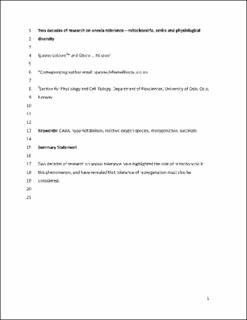| dc.description.abstract | Just over two decades ago, Bob Boutilier published a much-cited Review in this journal on the mechanisms of cell survival in hypoxia and hypothermia. Here, we celebrate this important Review by describing how our knowledge of the mechanisms behind anoxia tolerance have progressed since 2001, including new key roles of mitochondria, something Boutilier had started exploring. Evidence now suggests that, in anoxia-tolerant brains, mitochondria initiate responses aimed at suppressing electrical activity and energy use. These responses are largely dependent on gamma-aminobutyric acid (GABA) release. Animals that survive anoxia must also tolerate reoxygenation – a major challenge that could cause a massive production of damaging reactive oxygen species (ROS). Here, the handling of succinate, which builds up during anoxia, is critical. Interestingly, there are clear species differences in succinate handling among anoxia-tolerant vertebrates (Trachemys and Chrysemys turtles and crucian carp, Carassius carassius). Trachemys turtles suppress succinate build-up during anoxia, presumably to limit ROS production during reoxygenation. By contrast, in crucian carp, reduction of fumarate to succinate during anoxia appears to be essential for keeping their mitochondria charged and viable. Consequently, during anoxia, crucian carp accumulate much more succinate than Trachemys turtles. Moreover, during anoxia, succinate is apparently transported from crucian carp brain and heart to the liver, which handles succinate upon reoxygenation. This is one example of the striking physiological diversity among vertebrates that survive long-term anoxia. More examples are given, and we argue that -omics approaches are, and will be, helpful in providing new insight and moving the field forward. | en_US |

